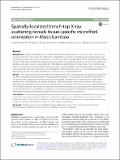Spatially-localized bench-top X-ray scattering reveals tissue-specific microfibril orientation in Moso bamboo
Author(s)
Ahvenainen, Patrik; Kallonen, Aki; Suhonen, Heikki; Svedström, Kirsi; Dixon, Patrick Gerard; Gibson, Lorna J.; ... Show more Show less
DownloadGibson_Spatially-localized.pdf (2.668Mb)
PUBLISHER_CC
Publisher with Creative Commons License
Creative Commons Attribution
Terms of use
Metadata
Show full item recordAbstract
Background: Biological materials have a complex, hierarchical structure, with vital structural features present at all size scales, from the nanoscale to the macroscale. A method that can connect information at multiple length scales has great potential to reveal novel information. This article presents one such method with an application to the bamboo culm wall. Moso (Phyllostachys edulis) bamboo is a commercially important bamboo species. At the cellular level, bamboo culm wall consists of vascular bundles embedded in a parenchyma cell tissue matrix. The microfibril angle (MFA) in the bamboo cell wall is related to its macroscopic longitudinal stiffness and strength and can be determined at the nanoscale with wide-angle X-ray scattering (WAXS). Combining WAXS with X-ray microtomography (XMT) allows tissue-specific study of the bamboo culm without invasive chemical treatment. Results: The scattering contribution of the fiber and parenchyma cells were separated with spatially-localized WAXS. The fiber component was dominated by a high degree of orientation corresponding to small MFAs (mean MFA 11°). The parenchyma component showed significantly lower degree of orientation with a maximum at larger angles (mean MFA 65°). The fiber ratio, the volume of cell wall in the fibers relative to the overall volume of cell wall, was determined by fitting the scattering intensities with these two components. The fiber ratio was also determined from the XMT data and similar fiber ratios were obtained from the two methods, one connected to the cellular level and one to the nanoscale. X-ray diffraction tomography was also done to study the differences in microfibril orientation between fibers and the parenchyma and further connect the microscale to the nanoscale. Conclusions: The spatially-localized WAXS yields biologically relevant, tissue-specific information. With the custom-made bench-top set-up presented, diffraction contrast information can be obtained from plant tissue (1) from regions-of-interest, (2) as a function of distance (line scan), or (3) with two-dimensional or three-dimensional tomography. This nanoscale information is connected to the cellular level features.
Date issued
2017-01Department
Massachusetts Institute of Technology. Department of Materials Science and EngineeringJournal
Plant Methods
Publisher
Biomed Central Ltd
Citation
Ahvenainen, Patrik et al. “Spatially-Localized Bench-Top X-Ray Scattering Reveals Tissue-Specific Microfibril Orientation in Moso Bamboo.” Plant Methods 13, 1 (January 2017) © 2017 The Author(s)
Version: Final published version
ISSN
1746-4811